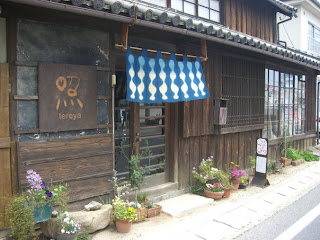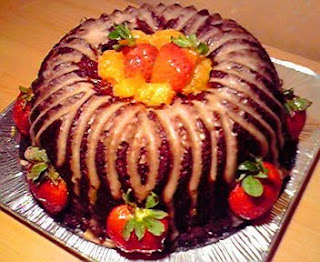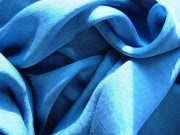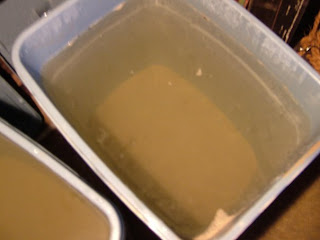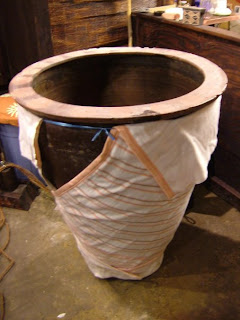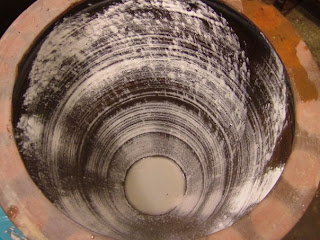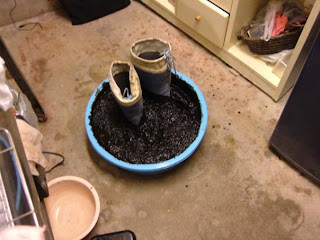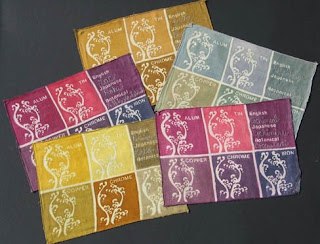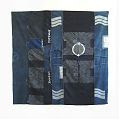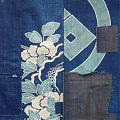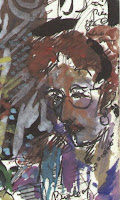FOR DIRECT APPLICATION KUSAKI-ZOME for batik, tie dye, stenciling, painting, and block printing
MAKING SOY MILK or GOJIRU
Before applying natural dye it is important to wash the fabric to remove all commercial sizing. In addition it is necessary to prepare the surface of the fabric. A mixture of soy bean milk and water brushed over the surface of the fabric, acts as a size. It helps to insure dye absorption, and prevents streaking. It also helps do keep dye from seeping under any resists. The fabric undergoes a structural change known as denaturation when brushed with soy bean milk. The protein in the milk is rendered insoluble and forms a permanent size on the fabric. This helps to reinforce the bond between the dye and the fiber.
Powdered soy milk from the health food store can be used. It can be mixed according to the directions on the package.
Whole milk can also be used in the proportions of 1 part milk to 4 parts water.
-----------------------------------------------------
TO MAKE SOY MILK
Measure by volume:
Dry soy beans........................500 cc. Add enough water to the soy beans to make 1 liter.
Allow them to soak at least 24 hours before using. After soaking, the beans will make about 800 cc. of softened beans. The softened beans may be refrigerated or frozen until needed. The frozen beans should be defrosted before using.
Add enough water to the softened beans to make 1 liter of beans. Liquify in a blender. Strain through a moistened cloth to remove the vegetable matter. Add 10% sodium alginate before applying to the fabric.
--------------------------------------------------------------
Before applying the milk the fabric should be stretched tightly on a frame or with Japanese harite and shinshi (tenter hooks) Paint the milk on the front of the fabric. Turn the fabric over and wipe on the reverse side with a clean cloth or brush. The milk is only applied once. The fabric that has been treated with milk must be dried quickly. This can be done easily by brushing on the milk in the sun, placing a heater near the fabric, or turning up the heat in the room. A hair dryer works well for small pieces. If the milk is not dried quickly it has a tendency to sour on the fabric. It is not necessary to apply the milk to yarn or fabric that will be immersion dyed. If yarn will be directly dyed for ikat it will be necessary to paint on the milk while the yarn or fabric is stretched prior to painting or tying.
When the milk is dry, apply the dye on the fabric or yarn using a brush, stencil, or by painting.
When dried the dye can be applied again. This may repeated several times until the desired shade or color is obtained.
To change colors, different dyes may be applied one over the other or mixed together before using. To deepen the colors the mordant may be applied alternating between applications of color.
If the dye beads on the surface of the fabric or yarn, a drop of glycerine can be added to the dye, Glycerine breaks the surface tension of the fiber allowing the dye to soak in.
FOR IMMERSION DYEING
Yarn or fabric must be washed to remove all sizing, grease, spinning oil and and must be wetted-out before dyeing. Then the fabric may be tie dyed, or just immersed into the dye.
After the dye is extracted, the yarn or fabric is boiled in the dye bath for 15 to 20 minutes. After cooling down it is then placed in the mordant bath for 30 minutes and then washed in water. The dye liquor is heated once more. The mordant treated fibers are again placed in the same heated dye. This process of mordant, then dye can be repeated several times to get the desired color. When finished the yarn should remain in the dye until it cools. It is then removed and washed in clean water several times. After washing, the fiber is left to dry.

